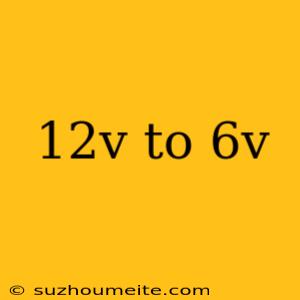12V to 6V: Converter Options and Applications
When working with electrical systems, it's not uncommon to encounter situations where a device or component requires a different voltage level than what's available. One such scenario is when you need to power a 6V device using a 12V power source. In this article, we'll explore the options for converting 12V to 6V and discuss their applications.
Why Convert 12V to 6V?
There are several reasons why you might need to convert 12V to 6V:
- Compatibility: Some devices, such as old appliances or vintage electronics, may only accept 6V input.
- Safety: Reducing the voltage can help prevent damage to sensitive components or prevent overheating.
- Efficiency: Lowering the voltage can improve the efficiency of certain devices, such as LED lights or small motors.
Converter Options
There are several ways to convert 12V to 6V, each with its own advantages and limitations:
Voltage Regulator
A voltage regulator is an electronic component that can step down the voltage from 12V to 6V. These regulators are available in various packages, including linear and switching types.
- Advantages: Simple to use, low cost, and widely available.
- Disadvantages: Can generate heat, may not be suitable for high-current applications.
** Buck Converter**
A buck converter is a type of switching regulator that can efficiently convert 12V to 6V. These converters use high-frequency switching to minimize energy losses.
- Advantages: High efficiency, low heat generation, and suitable for high-current applications.
- Disadvantages: More complex to design and build, may require additional components.
Resistive Divider
A resistive divider is a simple and passive way to convert 12V to 6V. This method involves connecting two resistors in series to divide the input voltage.
- Advantages: Simple and inexpensive, no heat generation.
- Disadvantages: Not suitable for high-current applications, can be affected by load changes.
Transformer
A transformer can be used to step down the voltage from 12V to 6V. This method involves winding the transformer to achieve the desired voltage ratio.
- Advantages: High efficiency, suitable for high-power applications.
- Disadvantages: Larger and heavier than other options, may require additional components.
Applications
Converting 12V to 6V has numerous applications in various industries:
- Automotive: Convert 12V from a car battery to power 6V accessories, such as fans or lights.
- Industrial: Power 6V devices, such as sensors or relays, from a 12V power source.
- Consumer Electronics: Convert 12V from a wall adapter to power 6V devices, such as toys or gadgets.
Conclusion
Converting 12V to 6V is a common requirement in various electrical systems. By understanding the different converter options and their applications, you can choose the most suitable solution for your specific needs. Whether you're working on a DIY project or designing a commercial product, converting 12V to 6V can be a crucial step in ensuring compatibility, safety, and efficiency.
